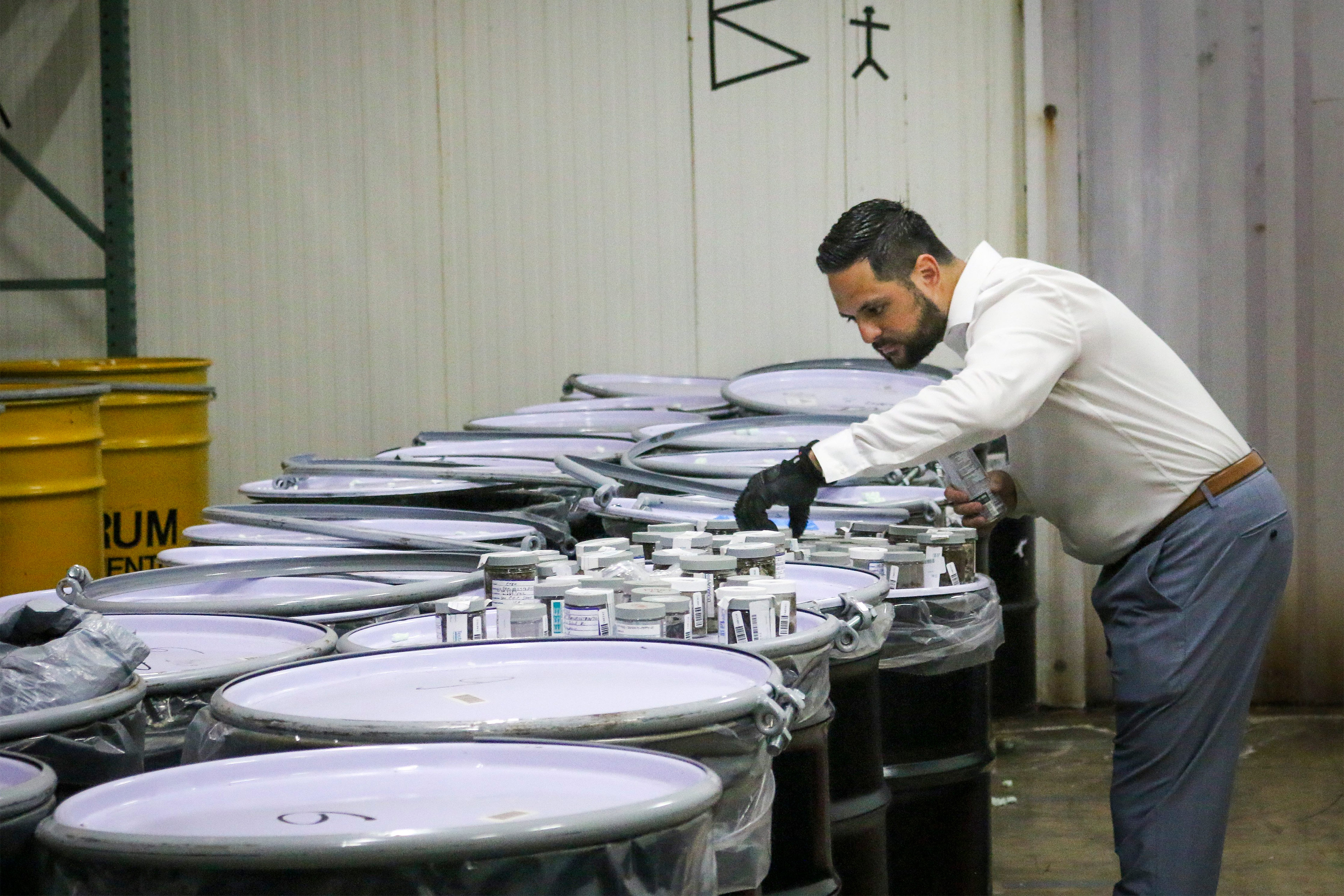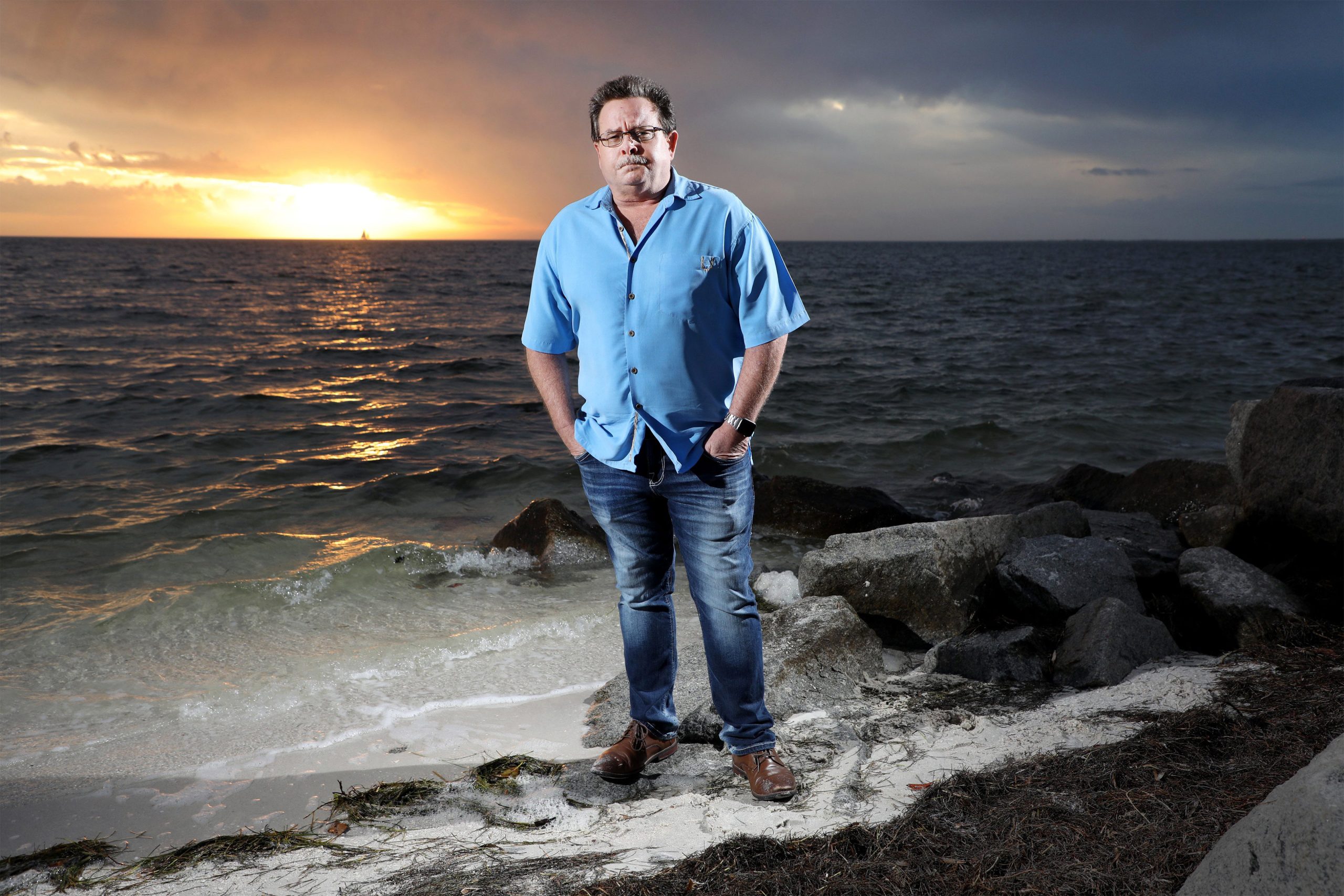The oil washed ashore every day, globs of tarlike ooze blighting sugar-white sand beaches. Rodney Boblitt’s job was to report it.
A special agent for the Florida Department of Environmental Protection, he was assigned to patrol 14 miles of Panhandle beaches on an all-terrain vehicle, alerting cleanup crews to new slicks from the BP Deepwater Horizon oil rig explosion.
His 16-hour shifts started at dawn. The air felt greasy; the ATV splashed up oil, he said, soaking his clothes, gun belt, hat, and boots.
“The smells were horrendous,” he recalled. “Like the ocean mixed with chemicals.”
About 4 million barrels of crude oil seeped into the Gulf of Mexico and 11 people died in the April 2010 disaster, the largest marine oil spill in history. Tens of thousands of workers were hired to clean sludge on beaches, mangroves, and dunes across Alabama, Mississippi, Louisiana, Texas, and the Florida Panhandle.
Boblitt said he wasn’t the same when he returned to his regular job after three months in the Panhandle. He struggled to concentrate. Knowledge gleaned from years of service eluded him. Physically demanding work caused him to shake.
Within two years, he said, he’d deteriorated so much he no longer trusted himself to handle airboats, personal watercraft and his firearm safely.
He took early retirement. He was 43.
More than a decade after the disaster, cleanup workers are still reporting cases of respiratory illnesses, skin disorders, dizziness, and other medical issues they say were caused by the spill. Their health struggles are documented in more than 5,000 lawsuits filed against BP in federal courts in Louisiana, Alabama, Mississippi, and Florida, with some workers reporting illnesses diagnosed as recently as 2020.
BP has so far set aside nearly $70 billion for the ecological disaster, including $11.6 billion to businesses affected by the spill, according to its website.
Payouts for cleanup workers’ medical claims make up a tiny portion of that restitution. According to a 2019 report from the court-appointed claims administrator, BP paid roughly $67 million to 22,833 workers to settle a class-action lawsuit, an average of about $3,000 each.
The petroleum giant also agreed in the 2012 settlement that cleanup workers could seek compensation for exposure symptoms that emerged later. But BP attorneys are aggressively contesting the new lawsuits — despite government-funded studies showing that these workers have higher-than-normal incidences of skin conditions, respiratory issues, and heart ailments.
BP officials declined to comment on the health claims filed against them. In multiple ongoing lawsuits, including the ongoing case filed by Boblitt against the oil giant, they maintain there’s no evidence that workers’ health problems were caused by the spill.
That burden of proof has become a very high bar for potential victims seeking compensation, according to plaintiffs’ attorneys. It has led some to stop accepting new cases. And on Jan. 24, a federal court effectively ended four cases filed by cleanup workers when it ruled that an expert hired by their attorneys had failed to prove their conjunctivitis and sinus problems were a direct result of the spill.
Allen Lindsay Jr., an attorney from the city of Milton in the Panhandle, has represented around 150 cleanup workers. He’s lost a third of those cases and is pessimistic about the remaining ones.
“I have to prove causation, that the poison on the beach is what poisoned our clients,” he said. “And we can’t do that.”
The legal battle has gotten so heated that attorneys at a Miami law firm have amassed a war chest of evidence — 130,000 samples of contaminated water, sand, sediment, wildlife, and tar balls — they believe will give them an edge in the courtroom.

Cleanup was dirty.
Some workers dragged oil booms to contain slicks in the Gulf. Others shoveled oil-soaked sand into trash bags and scrubbed oil from shoreline plants and jetties.
Workers who cleaned up the Exxon Valdez oil spill in Alaska faced similar conditions and have said they were still suffering health issues long after the 1989 disaster. But the medical impacts were never studied, according to a 2010 McClatchy report.
That won’t happen with the BP spill. A year after the disaster, researchers at the National Institute of Environmental Health Sciences began the Gulf Study, surveying 33,000 cleanup workers. The largest-ever analysis of the health impacts from an oil spill included home visits to about 11,000 participants, including 3,000 in Florida, to draw blood samples and test lung function and blood pressure.
By that time, oil products such as the carcinogen benzene were no longer present in blood samples, according to Dale Sandler, lead investigator and chief of the institute’s epidemiology branch. That made determining exposure levels a challenge.
The studies have documented several elevated health risks among cleanup workers.
Those with the highest levels of exposure suffered a higher-than-normal incidence of itchy eyes, burning throats, coughing, wheezing, and skin irritation, one of its studies found.
In the first three years after the disaster, the researchers found that the workers were 60% more likely than the general population to be diagnosed with asthma or experience respiratory symptoms. They also faced a higher risk of hypertension. Some reported dizziness, nausea, and stumbling.
Workers exposed to smoke and fumes when BP briefly tried burning oil slicks in the Gulf have experienced increased rates of heart disease and reduced lung capacity, the researchers found.
More than a decade after the disaster, researchers have yet to determine longer-term issues, said Sandler. And it’s too soon to say whether exposure will result in higher rates of cancer and lower life expectancy. Cancers can take up to 15 years to develop, she said.
Every year that passes makes figuring out what made workers sick more difficult, she said. The study revealed many don’t have access to consistent health care. They’ve since worked other industrial jobs with health risks.
She fears their plight will largely be forgotten.
“These people have real illnesses,” Sandler said. “There’s no magic-bullet biological marker that says it was the oil spill that caused this.”
Cleanup worker Vincent Culliver remembers crews would walk in pairs each morning for a mile up and down the beach.
“The more you dug,” he said, “the more oil you’d see.”
Clearing oil from the beach was like trying to scoop up an octopus with a shovel, he recalled.
“Some was mushy, some was slimy,” said Culliver, now 56. “It slid off the shovel, so sometimes you’d have to take your hands and scoop it up to get it into the bag.”
He worked 12-hour shifts along the Pensacola shoreline. The fumes, he said, were like holding a car’s oil dipstick to your nose.
After clearing tar for hours, Culliver would ball up his stained jeans and T-shirt and leave them in his garage to be washed. A father of five, he didn’t want his soiled clothes indoors.
“It was always somewhere: in my shoes. On my socks. On my pants,” he said.
For about four months in 2010, Culliver worked in Pensacola, according to his pending lawsuit filed about a year and a half ago against BP. He worked seven days a week, earning $12 an hour, he said. When the job dried up, he picked up a gig in Grand Isle, Louisiana, washing oil booms.
A few weeks into that job, a wood pallet broke, and he fell into a pit of oil and contaminated water. The nearest hospital was over an hour away. Culliver was forced to stay in the pit up to his waist, his back in searing pain, for roughly an hour.
“I was screaming, ‘My back! My back!’” Culliver said. “They would not move me because of my back.”
In 2019, a year after marrying, Culliver was diagnosed with prostate cancer.
His lawsuit alleges the BP oil spill “was a substantial contributing cause” of his illness.
“It’s been tough, but we both have a lot of faith, and we pray a lot,” said his wife, Barbara Culliver. “That’s what keeps us going.”
Lindsay, the Panhandle attorney, has spent years trying to prove the spill made his clients sick.
It’s been a costly endeavor. Court filing fees are upward of $400 per case, and each lawsuit has to be submitted individually.
About two-thirds of cleanup workers surveyed for the Gulf Study reported household incomes below $50,000. Only 15% had a college degree.
“All these people have been denied justice because BP turned their back on them,” Lindsay said. “They needed these people to clean up their mess.”
Like Lindsay, other attorneys have stopped accepting BP cases as they face an opponent they perceive as having near-unlimited resources.
Houston-based lawyer Howard Nations said the cost of litigation is more than what his clients could hope to win in damages. BP, he said, has developed a “scorched-earth” policy: Defend every single case.
Larger firms have the resources for the drawn-out legal fight, but even some of those have dropped out.
“When you litigate against a corporate giant like this, the common narrative that you’re going to see is a war of attrition. And that’s exactly what BP has defaulted to in this litigation,” said Dylan Boigris, a partner at Downs Law Group in Miami, which represents 50 Florida cleanup workers.
In determining exposure, courts have been relying on water sample data BP collected during the spill. A key argument made by Boigris and his firm is that BP skewed the results to make it seem as if the oil on beaches wasn’t toxic.
“What they try to argue is that what arrived on the beach was ‘weathered’ oil and that it was effectively dead oil — that there’s nothing harmful and that it’s no different than a rock,” Boigris said.
And BP attorneys have convinced courts that those seeking damages must determine what level of exposure to crude oil is harmful, court records show. That would be like trying to prove exactly how many cigarettes caused somebody’s cancer, Boigris said.
His firm has gone to considerable expense to counter that.
In 2019, BP prepared to dispose of samples from the spill. Boigris and his team drove to Colorado with six refrigerated trucks to retrieve them.
Since then, the firm says, it has paid as much as $150,000 per year to store the samples in a South Florida warehouse. The law firm’s enlisted experts are studying the samples and “unraveling the perception that there was no harmful exposure,” Boigris said.
One late November morning, Boigris and his team met at the facility, where stacks of freezers keep samples as cold as minus 112 degrees Fahrenheit. Donning gloves, Boigris was shrouded in water vapor as he carefully pulled open the freezer.


The firm plans to have some samples analyzed by independent toxicologists and hopes to use the data as evidence.
It’s why Boigris views his firm as “the last hope” for any workers seeking justice.
“BP went out and hired the indigent, and the underrepresented, and they took advantage of those local populations,” he said. “They sent them out there to clean up their oil, and they’ve discarded them.”
In the years after his stint in the Panhandle, Boblitt, the retired environmental special agent, says he burned through sick leave.
He was diagnosed with chronic rhinosinusitis and other sinus conditions that doctors told him were caused by breathing in fumes, according to his lawsuit. Court records show he was paid $1,300 in compensation in the 2012 settlement.
Figuring out what was wrong with his memory and concentration proved more difficult. Tests for Lyme disease and other neurological conditions came back negative, he said.
Then he and his wife, Debi Boblitt, watched a 2015 Vice news report on health issues faced by cleanup workers, some of whom reported similar symptoms.
“Every single symptom they were naming, he had,” she said.
A neurology specialist diagnosed Boblitt with toxic encephalopathy, a brain dysfunction caused by exposure to toxic substances. Now 54, he said he also suffers from depression, sleep apnea, and post-traumatic stress disorder, and he pays for life insurance that covers cancer.
“I don’t know whether they can fix me,” he said of the neurologists who care for him. “It’s like being an Alzheimer’s patient, where your memories are slipping.”
Boblitt’s biggest regret is that his medical saga affected his relationship with his youngest daughter, who just turned 18. She was in elementary school when his health began to fail. Before the spill, he lavished attention on her as soon as he would get home from work.
After, he frequently needed to lie down while his daughter was told to play quietly. On vacations, he would often remain in the hotel or cabin.
“My older two children got the real me,” he said. “She’s the one that has been affected the most.”
This article was produced in partnership with the Tampa Bay Times.



